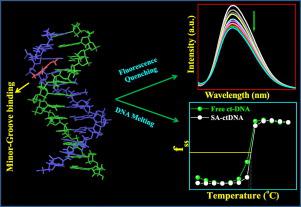Spectrochimica Acta Part A: Molecular and Biomolecular Spectroscopy ( IF 4.4 ) Pub Date : 2020-09-11 , DOI: 10.1016/j.saa.2020.118936 Prasenjit Mondal , Priti Sengupta , Uttam Pal , Sutapa Saha , Adity Bose

|
3,5-Dimethoxy-4-hydroxycinnamic acid commonly known as Sinapic acid is a well-known derivative of hydroxycinnamic acids, is commonly present in human diet. Due to its wide variety of pharmacological activities like antioxidant, antimicrobial, anti-inflammatory, anticancer, and anti-anxiety, it has attracted much attention for the researchers. In our previous published work we have already analyzed the interaction between sinapic acid (SA) with a model transport protein. In this work our aim is to demonstrate a detailed investigation of the binding interaction between sinapic acid with another carrier of genetic information in a living cell, the DNA. Here we have used calf thymus DNA (ct-DNA) as a model. The binding characteristic of SA with ct-DNA was investigated by different spectroscopic and theoretical tools. The spectroscopic investigation revealed that quenching of intrinsic fluorescence of SA by ct-DNA occurs through dynamic quenching mechanism. The thermodynamic parameters established the involvement of hydrogen bonding and weak van der Waals forces in the interaction. Further, the circular dichroism, competitive binding experiment with ethidium bromide and potassium iodide quenching experiment suggested that SA possibly binds to the groove position of the ct-DNA. Finally, molecular docking analysis established the SA binds to minor groove position of ct-DNA in G-C rich region through hydrogen bonding interaction. Additionally, gel electrophoresis analysis has been performed to determine the protective efficacy of SA against UVB induced DNA damage and 50 μM of SA was found to protect the DNA from UVB induced damage. We hope that our study could provide the validation of SA on behalf of therapeutics and development of next generation therapeutic drug as well as designing new efficient drug molecule and methodology for the interaction study of the drug with DNA.
中文翻译:

生物活性化合物3,5-二甲氧基-4-羟基肉桂酸与小牛胸腺DNA相互作用的生物物理和理论研究
3,5-二甲氧基-4-羟基肉桂酸通常被称为Sinpicic acid是羟基肉桂酸的众所周知的衍生物,通常存在于人类饮食中。由于其广泛的药理活性,例如抗氧化剂,抗菌剂,消炎药,抗癌药和抗焦虑药,它引起了研究人员的广泛关注。在我们先前发表的工作中,我们已经分析了芥子酸(SA)与模型转运蛋白之间的相互作用。在这项工作中,我们的目的是证明对芥子酸与活细胞中另一种遗传信息载体之间的结合相互作用的详细研究。在这里,我们使用小牛胸腺DNA(ct-DNA)作为模型。用不同的光谱学和理论工具研究了SA与ct-DNA的结合特性。光谱研究表明,ct-DNA可以通过动态猝灭机制猝灭SA的固有荧光。热力学参数确定了相互作用中氢键和弱范德华力的参与。此外,圆二色性,与溴化乙锭的竞争性结合实验和碘化钾猝灭实验表明,SA可能与ct-DNA的凹槽位置结合。最后,分子对接分析确定了SA通过氢键相互作用与GC富集区域中ct-DNA的较小凹槽位置结合。此外,已进行凝胶电泳分析以确定SA对UVB诱导的DNA损伤的保护作用,发现50μMSA可以保护DNA免受UVB诱导的损伤。



























 京公网安备 11010802027423号
京公网安备 11010802027423号